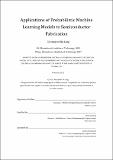Applications of Probabilistic Machine Learning Models to Semiconductor Fabrication
Author(s)
Lang, Christopher Ilic
DownloadThesis PDF (4.111Mb)
Advisor
Boning, Duane S.
Terms of use
Metadata
Show full item recordAbstract
Semiconductor fabrication relies heavily on the precision and accuracy of its individual processes in order to meet device requirements. If left unchecked, variations in these processes can lead to decreased performance and yield of the final product. While analysis and control of these variations have been employed for decades, recent developments in machine learning have introduced a wide variety of new methods that can potentially be used to better model, monitor, and control these processes. These methods offer the possibility of being more powerful, scalable, and accurate than traditional process control methods.
While many machine learning methods are promising, unique aspects of semiconductor fabrication create challenges for many machine learning approaches. In particular, the high cost of semiconductor fabrication often results in data limited scenarios, as collecting large quantities of data can be infeasibly expensive. Because of this limitation, we investigate the use of probabilistic methods in a variety of semiconductor fabrication settings. These methods are often less prone to overfitting compared to alternative machine learning methods, while still being flexible enough to model complex systems. Specifically, we investigate the application of probabilistic machine learning methods in four distinct case studies.
First, we study virtual metrology systems, with two goals in mind. Our first goal is to define a virtual metrology framework that allows us to better understand the sources of error commonly seen in these systems. This framework relates the recipe, chamber, sensor, and wafer variables, and incorporates two common sources of error: observability errors and concept drift. Our second goal is to then use this framework to develop our own modeling approach that is well suited to model systems where these errors are present. Our solution is a Bayesian approach that is similar to the traditional Kalman filter; however, it models the relationship between two variables, as opposed to an unknown system state.
We then investigate a probabilistic method for optimizing dose uniformity in ion implantation systems. A common approach for improving dose uniformity relies on adjusting the implantation time across the wafer in order to compensate for beam variations. Here, we learn these variations, then solve for a set of compensating times. Our approach is comprised of two components, a modeling component and an optimization component. The modeling component is similar to the probabilistic method we use for modeling virtual metrology systems, but also incorporates prior beliefs tailored to the ion implantation setting. The optimization component then uses our forward model to improve dose uniformity given physical constraints of the tool and process. We compare this method to the prior existing industry tuning method, and see significant improvements in tuning time, process throughput, and tuning success.
Next, we investigate probabilistic anomaly detection methods, which we use to detect process faults as they occur. These methods use process sensor information to determine whether the current process is operating nominally or not. We use kernel density estimation methods to estimate probability distributions for the sensor signals under normal operating conditions; These distributions are then used to determine the likelihood that a process is operating nominally. The approach is shown to compare favourably to a number of traditional process control methods, including statistical process control, one-class support vector machines, as well as variational auto encoder based anomaly detection methods.
Finally, we investigate the use of Bayesian optimization and Gaussian process models to improve thickness uniformity in sputtering deposition processes. Here, we use Gaussian processes to model the thickness uniformity in sputtering deposition processes as a function of both chamber configuration and recipe parameters. This model is used in an iterative manner to find parameters that meet the desired uniformity requirements. Our modeling technique compares favourably to a number of standard regression approaches, including polynomial models, multivariate splines, gradient boosted regression trees, and a number of different deep learning architectures.
While these four case studies each consider a unique application of probabilistic methods to semiconductor fabrication, two key themes run throughout. First, we find that these probabilistic methods are less prone to overfitting in data limited scenarios compared to many alternative methods. The inherent regularization provided by priors and observation noise estimates is key to the success of these methods. Second, the incorporation of process or domain specific knowledge is crucial to training with limited data. Understanding the underlying system, structuring the approach accordingly, and making minor approximations reduces the complex original problems to a simpler form, enabling effective application of probabilistic machine learning methods.
Date issued
2022-02Department
Massachusetts Institute of Technology. Department of Electrical Engineering and Computer SciencePublisher
Massachusetts Institute of Technology